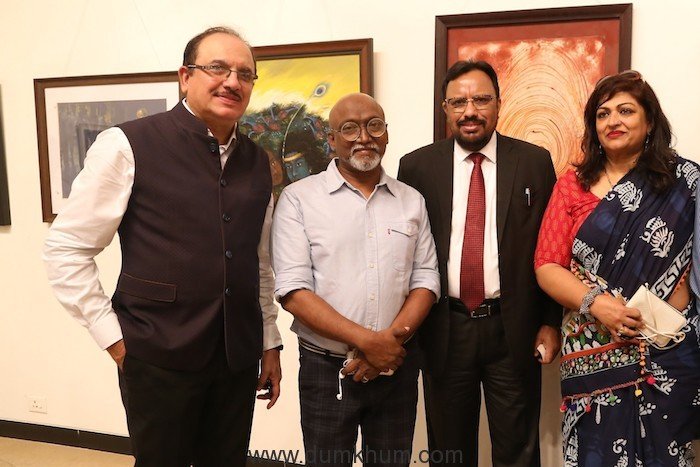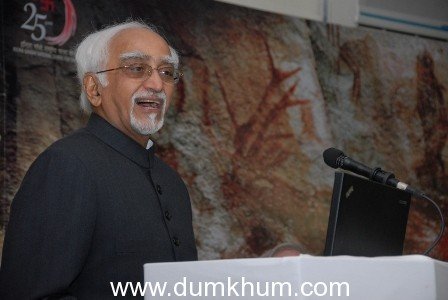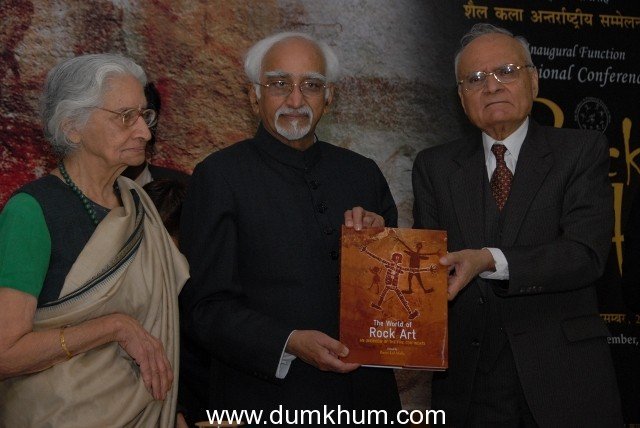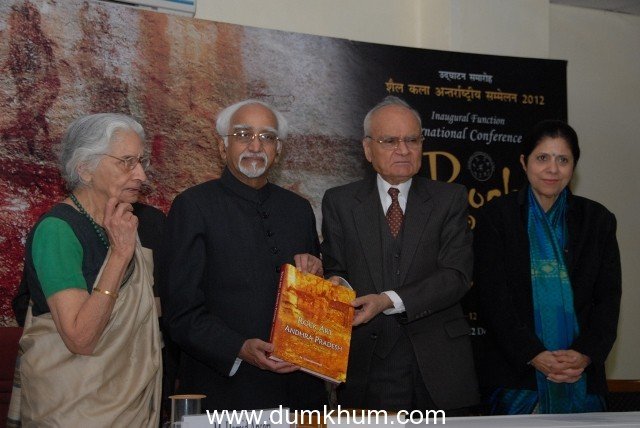Pressures of urbanization threatening historic monuments and Rock Art sites, says Vice President
The 45 days festival was inaugurated by Hon’ble Vice President of India Shri M. Hamid Ansari and Hon’ble Union Minister of Culture Ms. Chandresh Kumari Katoch
· Scholars from 20 countries will be participating in the festival to deliberate over the new ways to preserve and understand this ancient art form
Dr Ansari honored Dr Yashodhar Mathpal, a noted Rock Art conservationist on this occasion.
New Delhi, The pressures of urbanization and population growth are threatening country’s historic monuments and prehistoric rock art sites and immediate actions are required to prevent the “irreparable damage” to these treasures, Hon’ble Vice President of India Shri M. Hamid Ansari today said while inaugurating the International Conference on Rock Art 2012 here.
“The pressures of organization and population growth are not only threatening our historic monuments but also pre historic rock art sites. Unless we act quickly to improve the manner in which we look after these treasures, irreparable damage could be caused.
This is a great national enterprise in which in which different arms of the government should partner with civil society and local communities with required imagination and administrative resolves. There is a growing recognition of the need for a multi disciplinary approach to rock art studies given its archeological worth and utility as a tool; for developing a better understanding among the people of the world,” Shri Ansari said.
The 45-days long festival is being organized by Indira Gandhi National Centre for the Arts along with Ministry of Culture, Government of India to popularize and protect the pre-historic rock art, one of the most ancient form of human expression.
The festival will feature an exhibition showcasing pictorial depiction of rock art sites from India and across the globe, an academic conference on conservation of this ancient art by scholars from 20 countries as well as live workshops on Indian tribal and folk arts that has the continuing tradition of rock art.
“I am happy to be here today for the inauguration of the international conference of rock art being organized by the Indira Gandhi National Centre for the Arts. I extend a warm welcome to the distinguished scholars who have come from various parts of the world to participate in it,” the Vice President added hailing the initiative.
India is fortunate to posses one of the three largest concentration of this world heritage the other two being Australia and South Africa, where rock art is still a living pursuit.
To make people experience the unique nature of rock art, a cave-like set up has been designed on the lines of Bhimbetka, an archaeological World Heritage site located in Raisen District in Madhya Pradesh. The part of exhibition that features global rock art has been divided in zones showing art forms of different continents. The exhibition showcase rock arts pieces related to pre-historic era ranging between 4,000 and 12,000 BC.
The Indian wing also exhibits various tribal art forms that shows continuity of the tradition of rock art. The art forms includeSaura (Odisha), Warli (Maharashtra) and Rathwa from Gujarat.
During the workshop, the rock art scholars and artists across the globe would demonstrate the journey of rock art, techniques and materials used for its depiction along with similarity and their differences in the art form across the countries.
Renowned scholars from 20 countries representing five continents (Asia, South Africa, Australia, Europe and United States of America) would present review and overall status of rock art studies in their respective continents giving global insights into recent developments, challenges and problems through special lectures in the conference.
“This is an initiative which will help in understanding the roots of rock art and the journey since then, helping people to relate their theoretical knowledge with practical. India is fortunate in possessing one of the three largest concentrations of this world heritage. However, in India we still see a living continuity of this tradition in folk and tribal art forms. Therefore, it is a proud privilege for the IGNCA to host such an international conference. The conference is all the more relevant for the IGNCA as it is one of rare institution in the country to have a well developed research and documentation programme of rock art.” said Dipali Khanna, Member Secretary, Indira Gandhi National Centre for the Arts (IGNCA).
The conferences will mainly focus on the following themes: (i) Concept and Methodology (ii) Themes – (a) Forms (b) Content(c) Context (iii) Techniques (iv) Interpreting Rock Art – (a) Archaeological Approach (b) Ethnographic Approach (c) Psycho- analytical Approach (v) Interdisciplinary Approach (vi) Chronological Issues (vii) Cultural Ecology (viii) Documentation and Conservation. Experts and Scholars from India, France, Italy, Spain, Indonesia, Douth Africa, Australia, Poland, USA, Cuba, Peru, Bolivia, China and many other countries will address the issue and challenges for preservation of Rock Art.
About Indira Gandhi National Centre for the Arts (IGNCA):
Indira Gandhi National Centre for the Arts (IGNCA) was established in 1987 as an autonomous institution under the Ministry of Culture, as a centre for research, academic pursuit and dissemination in the field of the arts. The Arts’ encompass a wide range of subjects – from archaeology and anthropology to the visual and performing arts, enveloping them in a complementary and non-demarcated vision. In its functioning, the IGNCA has met its mandate and continues to work in this direction.
The IGNCA has six functional units – Kala Nidhi, the multi-form library; Kala Kosa, devoted mainly to the study and publication of fundamental texts in Indian languages; Janapada Sampada, engaged in lifestyle studies; Kaladarsana, the executive unit which transforms researches and studies emanating from the IGNCA into visible forms through exhibitions;Cultural Informatics Lab, which applies technology tools for cultural preservation and propagation; and Sutradhara, the administrative section that acts as a spine supporting and coordinating all the activities.










